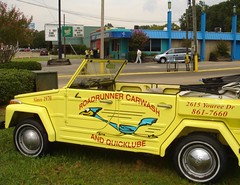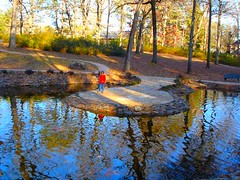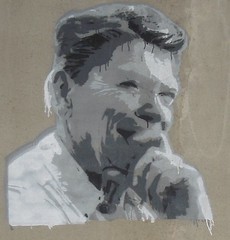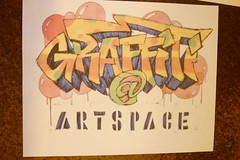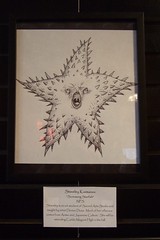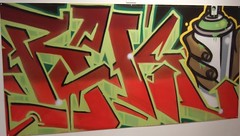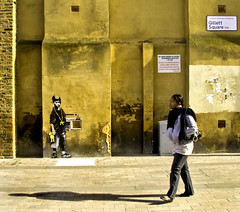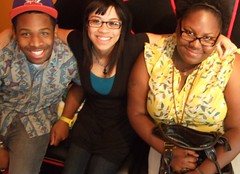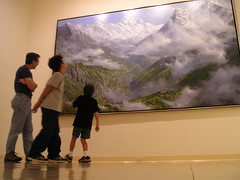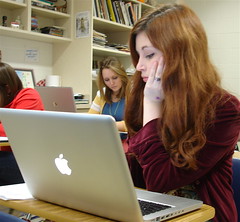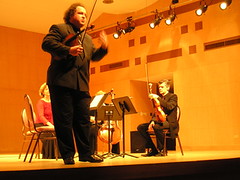Don't forget to invite your parents to take an art break on Thurs morn. They are encouraged to meet us at our special visit to RW Norton.
Ordinarily the museum opens at 10 am but we have cut a special deal, thanks to Lewis Norton.
Monday, August 31, 2009
Reading the class web site with an eye for detail and enlightenment: open notes quiz on Wed, Sept 2
Multiple choice quiz on notes at FineArtsMagnet web site on Wed.
Questions will begin with the week of Aug 17 and go in order to today.
Some 15 questions.
Questions will begin with the week of Aug 17 and go in order to today.
Some 15 questions.
Elgin or Parthenon Marbles
The Parthenon Marbles are a collection of classical Greek marble sculptures, inscriptions and architectural members that originally were part of the Parthenon and other buildings on the Acropolis of Athens, says Wikipedia.[1][2]
Thomas Bruce, 7th Earl of Elgin, the British ambassador to the Ottoman Empire from 1799–1803, had obtained a controversial permission from the Ottoman authorities to remove pieces from the Acropolis. From 1801 to 1812 Elgin's agents removed about half of the surviving sculptures of the Parthenon, as well as architectural members and sculpture from the Propylaea and Erechtheum.[3] The Marbles were transported by sea to Britain.
In Britain, the acquisition of the collection was supported by artists and others,[4] while some critics compared Elgin's actions to vandalism[5] or looting.[6][7][8][9][10] Following a public debate in Parliament and subsequent exoneration of Elgin's actions, the marbles were purchased by the British Government in 1816 and placed on display in the British Museum, where they stand now on view in the purpose-built Duveen Gallery.
The legality of the removal has been questioned and the debate continues as to whether the Marbles should remain in the British Museum or be returned to Athens.
Please follow up on the Elgin/Pathenon Marble sculptures by viewing images at Flickr.com and sites such as Parthenouk.com, dedicated to the return of the ancient work to Greece.
Thomas Bruce, 7th Earl of Elgin, the British ambassador to the Ottoman Empire from 1799–1803, had obtained a controversial permission from the Ottoman authorities to remove pieces from the Acropolis. From 1801 to 1812 Elgin's agents removed about half of the surviving sculptures of the Parthenon, as well as architectural members and sculpture from the Propylaea and Erechtheum.[3] The Marbles were transported by sea to Britain.
In Britain, the acquisition of the collection was supported by artists and others,[4] while some critics compared Elgin's actions to vandalism[5] or looting.[6][7][8][9][10] Following a public debate in Parliament and subsequent exoneration of Elgin's actions, the marbles were purchased by the British Government in 1816 and placed on display in the British Museum, where they stand now on view in the purpose-built Duveen Gallery.
The legality of the removal has been questioned and the debate continues as to whether the Marbles should remain in the British Museum or be returned to Athens.
Please follow up on the Elgin/Pathenon Marble sculptures by viewing images at Flickr.com and sites such as Parthenouk.com, dedicated to the return of the ancient work to Greece.
Sunday, August 30, 2009
The background to the realistic art found in the Norton: Classical Greek sculpture
Lysippos was a Greek sculptor of the 4th century BC, says Wikipedia. Together with Scopas and Praxiteles, he is considered one of the three great sculptors of the Classical Greek era, bringing transition into the Hellenistic period.
Notable: his large workshop, the demand for replicas of his work in his lifetime[1] and later among Hellenistic and Roman connoisseurs, the number of disciples directly in his circle,[2] and the survival of his works only in copies.
Among the works attributed to him are the so-called Horses of Saint Mark, Eros Stringing the Bow (of which various copies exist, the best in the British Museum), Agias (known for a marble copy found and preserved in Delphi), the similar Oil Pourer (Dresden and Munich), the Farnese Hercules (which was originally placed in the Baths of Caracalla, although the surviving marble copy lies in the Naples National Archaeological Museum) and Apoxyomenos (or The Scraper, known from a Roman marble copy in the Vatican Museums).
Herma bust of Alexander, Roman marble reflecting an original by Lysippos (Louvre)
Born at Sicyon around 390 BC Lysippos was a worker in bronze in his youth. He taught himself the art of sculpture, later becoming head of the school of Argos and Sikyon. According to Pliny, he produced more than 1,500 works, all of them in bronze. Commentators noted his grace and elegance, and the symmetria or coherent balance of his figures, which were leaner than the ideal represented by Polykleitos and with proportionately smaller heads, giving them the impression of greater height. He was famous for his attention to the details of eyelids and toenails.
His pupil, Chares of Lindos, constructed the Colossus of Rhodes, one of the Seven Wonders of the Ancient World. As this statue does not exist today, debate continues as to whether it was cast bronze or hammered of sheet bronze.
Notable: his large workshop, the demand for replicas of his work in his lifetime[1] and later among Hellenistic and Roman connoisseurs, the number of disciples directly in his circle,[2] and the survival of his works only in copies.
Among the works attributed to him are the so-called Horses of Saint Mark, Eros Stringing the Bow (of which various copies exist, the best in the British Museum), Agias (known for a marble copy found and preserved in Delphi), the similar Oil Pourer (Dresden and Munich), the Farnese Hercules (which was originally placed in the Baths of Caracalla, although the surviving marble copy lies in the Naples National Archaeological Museum) and Apoxyomenos (or The Scraper, known from a Roman marble copy in the Vatican Museums).
Herma bust of Alexander, Roman marble reflecting an original by Lysippos (Louvre)
Born at Sicyon around 390 BC Lysippos was a worker in bronze in his youth. He taught himself the art of sculpture, later becoming head of the school of Argos and Sikyon. According to Pliny, he produced more than 1,500 works, all of them in bronze. Commentators noted his grace and elegance, and the symmetria or coherent balance of his figures, which were leaner than the ideal represented by Polykleitos and with proportionately smaller heads, giving them the impression of greater height. He was famous for his attention to the details of eyelids and toenails.
His pupil, Chares of Lindos, constructed the Colossus of Rhodes, one of the Seven Wonders of the Ancient World. As this statue does not exist today, debate continues as to whether it was cast bronze or hammered of sheet bronze.
Realism. Dynamism. Kineticism: classical Greek sculpture as seen in the Nike of Samothrace / the Louvre
Movement. Drama. Dynamism. These three words describe the essence of the work of sculpture known as the Nike of Samothrace, says Art History at Loggia.com.
This image of the Greek goddess Nike demonstrates, in a powerful and impressive manner, the level of technical skill achieved by Hellenistic sculptors. The Nike of Samothrace is quite literally a tour de force of intricate carving and dynamic movement, an image of Victory captured for eternity.
For the ancient Greeks, the goddess Nike represented the personification of victory.
While she now commands attention in the Louvre as a free-standing statue, originally the Nike was part of scene that included a ship's prow. The beautiful goddess must have been an awe-inspiring sight, appearing to drift from the sky and land gracefully, wings still hovering in the air, draperies moving in the wind and revealing the elegant body underneath.
Today, in many ways the Nike celebrates the victory of beauty, as she symbolizes the ideals of perfection to which the ancient Hellenistic artists aspired. And the statue of the goddess still stands as a monument to a time of artistic splendor.
See more here. And see more at Wikipedia.org.
This image of the Greek goddess Nike demonstrates, in a powerful and impressive manner, the level of technical skill achieved by Hellenistic sculptors. The Nike of Samothrace is quite literally a tour de force of intricate carving and dynamic movement, an image of Victory captured for eternity.
For the ancient Greeks, the goddess Nike represented the personification of victory.
While she now commands attention in the Louvre as a free-standing statue, originally the Nike was part of scene that included a ship's prow. The beautiful goddess must have been an awe-inspiring sight, appearing to drift from the sky and land gracefully, wings still hovering in the air, draperies moving in the wind and revealing the elegant body underneath.
Today, in many ways the Nike celebrates the victory of beauty, as she symbolizes the ideals of perfection to which the ancient Hellenistic artists aspired. And the statue of the goddess still stands as a monument to a time of artistic splendor.
See more here. And see more at Wikipedia.org.
Thursday, August 27, 2009
Field trip to RW Norton Art Foundation on Thurs, Sept 3, 9:35 til 10:35 am
Norton's, one of Shreveport's almost-secret museums, is an amazing resource for the region. Paintings, sculpture, books, guns, dolls: almost everyone will find a niche of interest at Norton.
Parents are welcome to join us on the visit to RW Norton Art Foundation on Th, Sept 3. Would you please make the invitation for me?
We take this occasion to leave graffiti and break into a study of realistic paintings. since we will see a special exhibit at Norton on the work of illustrator / painter Albino Hinojosa.
Parents are welcome to join us on the visit to RW Norton Art Foundation on Th, Sept 3. Would you please make the invitation for me?
We take this occasion to leave graffiti and break into a study of realistic paintings. since we will see a special exhibit at Norton on the work of illustrator / painter Albino Hinojosa.
Hyperrealist Chuck Close: massive scale, uncanny realism
Chuck Thomas Close (born July 5, 1940, Monroe, Washington)[1] is an American painter and photographer who achieved fame as a photorealist, through his massive-scale portraits. Though a catastrophic spinal artery collapse in 1988 left him severely paralyzed, says Wikipedia.org, he has continued to paint and produce work which remains sought after by museums and collectors.
Most of his early works are very large portraits based on photographs (Photorealism or Hyperrealism technique). In 1962, he received his B.A. from the University of Washington in Seattle. He then attended graduate school at Yale University, where he received his MFA in 1964. After Yale, he lived in Europe for a while on a Fulbright grant. When he returned to the US, he worked as an art teacher at the University of Massachusetts.
Although his later paintings differ in method from his earlier canvases, the preliminary process remains the same. To create his grid work copies of photos, Close puts a grid on the photo and on the canvas and copies cell by cell. Typically, each square within the grid is filled with roughly executed regions of color (usually consisting of painted rings on a contrasting background) which give the cell a perceived 'average' hue which makes sense from a distance. His first tools for this included an airbrush, rags, razor blade, and an eraser mounted on a power drill. His first picture with this method was Big Self Portrait, a black and white enlargement of his face to a 107.5 in by 83.5 in (2.73 m by 2.12 m) canvas, made in over four months in 1968.
Most of his early works are very large portraits based on photographs (Photorealism or Hyperrealism technique). In 1962, he received his B.A. from the University of Washington in Seattle. He then attended graduate school at Yale University, where he received his MFA in 1964. After Yale, he lived in Europe for a while on a Fulbright grant. When he returned to the US, he worked as an art teacher at the University of Massachusetts.
Although his later paintings differ in method from his earlier canvases, the preliminary process remains the same. To create his grid work copies of photos, Close puts a grid on the photo and on the canvas and copies cell by cell. Typically, each square within the grid is filled with roughly executed regions of color (usually consisting of painted rings on a contrasting background) which give the cell a perceived 'average' hue which makes sense from a distance. His first tools for this included an airbrush, rags, razor blade, and an eraser mounted on a power drill. His first picture with this method was Big Self Portrait, a black and white enlargement of his face to a 107.5 in by 83.5 in (2.73 m by 2.12 m) canvas, made in over four months in 1968.
Photorealism and the artist Chuck Close
As a full-fledged art movement, Photorealism evolved from Pop Art[1][2] and as a counter to Abstract Expressionism[3][4] as well as Minimalist art movements[5][6][7][8] in the late 1960s and early 1970s in the United States.[9]
It is also sometimes labeled as Super-Realism, New Realism, Sharp Focus Realism, or Hyper-Realism, says Wikipedia.org.[10] The Photorealist genre is predominately made up of painters. The word Photorealism was coined by Louis K. Meisel in 1968.
Photorealist painting cannot exist without the photograph. In Photorealism, change and movement must be frozen in time which must then be accurately represented by the artist.[14] Photorealists gather their imagery and information with the camera and photograph. Once the photograph is developed (usually onto a photographic slide) the artist will systematically transfer the image from the photographic slide onto canvases. Usually this is done either by projecting the slide onto the canvas or by using traditional grid techniques.[15] The resulting images are often direct copies of the original photograph but are usually larger than the original photograph or slide. This results in the photorealist style being tight and precise, often with an emphasis on imagery that requires a high level of technical prowess and virtuosity to simulate, such as reflections in specular surfaces and the geometric rigor of man-made environs.[16]
20th century photorealism can be contrasted with the similarly literal style found in trompe l'oeil paintings of the 19th century. However, trompe l'oeil paintings tended to be carefully designed, very shallow-space still-lifes, employing illusionistic devices such as the use of shadows to cause small objects to appear to exist above the surface of the painting. (Trompe l'oeil literally means "fool the eye.") The photorealism movement moved beyond this illusionism to tackle deeper spatial representations (e.g. urban landscapes) and took on much more varied and dynamic subject matter.
It is also sometimes labeled as Super-Realism, New Realism, Sharp Focus Realism, or Hyper-Realism, says Wikipedia.org.[10] The Photorealist genre is predominately made up of painters. The word Photorealism was coined by Louis K. Meisel in 1968.
Photorealist painting cannot exist without the photograph. In Photorealism, change and movement must be frozen in time which must then be accurately represented by the artist.[14] Photorealists gather their imagery and information with the camera and photograph. Once the photograph is developed (usually onto a photographic slide) the artist will systematically transfer the image from the photographic slide onto canvases. Usually this is done either by projecting the slide onto the canvas or by using traditional grid techniques.[15] The resulting images are often direct copies of the original photograph but are usually larger than the original photograph or slide. This results in the photorealist style being tight and precise, often with an emphasis on imagery that requires a high level of technical prowess and virtuosity to simulate, such as reflections in specular surfaces and the geometric rigor of man-made environs.[16]
20th century photorealism can be contrasted with the similarly literal style found in trompe l'oeil paintings of the 19th century. However, trompe l'oeil paintings tended to be carefully designed, very shallow-space still-lifes, employing illusionistic devices such as the use of shadows to cause small objects to appear to exist above the surface of the painting. (Trompe l'oeil literally means "fool the eye.") The photorealism movement moved beyond this illusionism to tackle deeper spatial representations (e.g. urban landscapes) and took on much more varied and dynamic subject matter.
Evaluating the world of online learning: positive first steps
The NY Times presented an article about online learning that judges it to be perhaps more efficacious than traditional classroom-setting learning.
I found the feedback offered by NYTimes readers to be highly useful. Please sample the comments that follow this news story.
I found the feedback offered by NYTimes readers to be highly useful. Please sample the comments that follow this news story.
Evaluating the Graffiti exhibit at Artspace Shreveport
Additional guidelines for writing a traditional review of an art exhibit
* Describe the most dramatic piece that you remember. In either a direct or indirect way you can show your enjoyment and approval of this image. Or, likewise, you can begin to express your reservations or disapproval.
* Offer an overview of the experience or package: ie: videos, photos, paintings, participation wall, people, etc.
* Big Picture perspective: how does this flow with national or international events or concerns? Relevant?
* Philosophical prespective: worthy work? Provocative concept? Ho hum? Be sure to offer reasons for your judgment.
* For what audience do you judge this to be suitable? Why?
* Dates, hours, people and organization, location, parking, online site(s).
* Try not to slash and burn. Be diplomatic and measured in both praise and pejorative evaluations. Your reader expects you to find both things that are positive as well as not so positive (improvement needed) to say about an exhibit.
* Describe the most dramatic piece that you remember. In either a direct or indirect way you can show your enjoyment and approval of this image. Or, likewise, you can begin to express your reservations or disapproval.
* Offer an overview of the experience or package: ie: videos, photos, paintings, participation wall, people, etc.
* Big Picture perspective: how does this flow with national or international events or concerns? Relevant?
* Philosophical prespective: worthy work? Provocative concept? Ho hum? Be sure to offer reasons for your judgment.
* For what audience do you judge this to be suitable? Why?
* Dates, hours, people and organization, location, parking, online site(s).
* Try not to slash and burn. Be diplomatic and measured in both praise and pejorative evaluations. Your reader expects you to find both things that are positive as well as not so positive (improvement needed) to say about an exhibit.
Tuesday, August 25, 2009
Field trip to Artspace Shreveport's Graffiti exhibit on Wed remains on schedule!
Despite the fire that destroyed the SRAC offices and records, the show will go on. I have confirmed that the field trip will take place as scheduled.
Birth, death, love and dogs: the semiotics of graffiti artist Keith Haring
Semiotics, says Wikipedia, is the study of sign processes (semiosis), or signification and communication, signs and symbols, both individually and grouped into sign systems. It includes the study of how meaning is constructed and understood.
Keith Haring was one of the great semiotic artists.
Please see Vimeo.com for the video on Haring's work and significance that we watched in class.
Keith Haring was one of the great semiotic artists.
Please see Vimeo.com for the video on Haring's work and significance that we watched in class.
Monday, August 24, 2009
A Jewel in the crown of Shreveport: RW Norton Art Gallery
Get acquainted with a resource for art and history that is far more extensive than you could imagine: RW Norton Art Gallery.
* Your exploration begins with the updated RW Norton web site. It can continue with
* Subscribing to their fact-filled, emailed Norton Newsletter.
* Taking your camera and friends to trek across the grounds where you will see the steady developments.
* A class field trip, soon to be scheduled.
* Your exploration begins with the updated RW Norton web site. It can continue with
* Subscribing to their fact-filled, emailed Norton Newsletter.
* Taking your camera and friends to trek across the grounds where you will see the steady developments.
* A class field trip, soon to be scheduled.
A towering potato souffle: Guidelines for reviews of arts events . . .
Guidelines for arts reviews, whether indie movie, play, art exhibit, concert, etc.
1. Vivid opening. Mainly, an image you thought was one of the best elements of the show captured by a colorful description.
2. The overall impact or significance of the display or performance. Ex: The Graffiti show at Artspace attempts to broaden visitors' sense of the definition of fine arts.
3. Principal elements of the event or display.
4. Your evaluation: what you think was effective or appealing. Also, what you thought was difficult to understand or to like. Technical successes or problems. Philosophical approval or disagreements.
5. Names of people and / or groups responsible for the production.
6. Location, date(s). Ticket price.
7. Online source for more info.
8. Titling: snappy title, explanatory subtitle.
1. Vivid opening. Mainly, an image you thought was one of the best elements of the show captured by a colorful description.
2. The overall impact or significance of the display or performance. Ex: The Graffiti show at Artspace attempts to broaden visitors' sense of the definition of fine arts.
3. Principal elements of the event or display.
4. Your evaluation: what you think was effective or appealing. Also, what you thought was difficult to understand or to like. Technical successes or problems. Philosophical approval or disagreements.
5. Names of people and / or groups responsible for the production.
6. Location, date(s). Ticket price.
7. Online source for more info.
8. Titling: snappy title, explanatory subtitle.
Obey! Andre the giant and the other massive bureaucratic forces say ...
Due days mean at the end of the school day - 3:30 pm - on the day stated. That way your teacher can hit the scoring process right after classroom time.
Graffiti Artists Notes 10 pts. Due Tues., Aug 25.
Class Fee 10 pts. Due on Mon, Sept 7.
Comparison essay on classmate profiles 15 pts. Due Tuesday, Aug 25.
Background (your family/personal info) 3 pts. Due Wed, Aug 26.
Review of the Graffiti exhibit at Artspace 10 pts. Due Tues, Sept 1.
Arts Experience review / every 3 weeks 15 pts / due Mon, Sept 7
Graffiti Artists Notes 10 pts. Due Tues., Aug 25.
Class Fee 10 pts. Due on Mon, Sept 7.
Comparison essay on classmate profiles 15 pts. Due Tuesday, Aug 25.
Background (your family/personal info) 3 pts. Due Wed, Aug 26.
Review of the Graffiti exhibit at Artspace 10 pts. Due Tues, Sept 1.
Arts Experience review / every 3 weeks 15 pts / due Mon, Sept 7
Sex, war, birth, death: graffiti artist Keith Haring, 1958 - 1990
Keith Haring (May 4, 1958 – February 16, 1990) was an artist and social activist whose work responded to the New York City street culture of the 1980s, says his bio in Wikipedia.org.
Born in Reading, Pennsylvania, Haring grew up in Kutztown and was interested in art from an early age. From 1976 to 1978 he studied graphic design at The Ivy School of Professional Art, a commercial and fine art school in Pittsburgh. At age 19 Haring, who was openly gay,[1] moved to New York City, where he was inspired by graffiti art, and studied at the School of Visual Arts.
He achieved his first public attention with chalk drawings in the subways of New York (see public art). The exhibitions were filmed by the photographer Tseng Kwong Chi. Around this time, "The Radiant baby" became his symbol. His bold lines, vivid colors, and active figures carry strong messages of life and unity. Starting in 1980, he organized exhibitions in Club 57. He participated in the Times Square Exhibition and drew, for the first time, animals and human faces. In 1981 he sketched his first chalk drawings on black paper and painted plastic, metal and found objects.
By 1982, he established friendships with fellow emerging artists Kenny Scharf, Madonna and Jean-Michel Basquiat. He took part in the Whitney Biennial in 1983, as well as in the São Paulo Biennial. He got to know Andy Warhol, who was the theme of several of Haring's pieces including "Andy Mouse."
In 1985 he started to paint canvas. Simultaneously, the Museum of Modern Art in Bordeaux opened an exhibition of his works, and took part in the Paris Biennial. He made an appearance on MTV in November 1985, painting the set during a "guest VJ" special hosted by his friend, keyboardist Nick Rhodes of Duran Duran. In 1986 Haring painted murals in Amsterdam, Paris, Phoenix and in Berlin on the Berlin Wall at Brandenburg Gate. As well, he painted the body of Grace Jones for her music video "I'm Not Perfect." and opened a retail store in SoHo called Pop Shop, selling merchandise bearing his iconic images; the outlet closed in 2005. By then, his work began reflecting more socio-political themes, such as anti-Apartheid, AIDS awareness, and the crack cocaine epidemic. He even created several pop art pieces influenced by other products: Absolut Vodka, Lucky Strike cigarettes, and Coca-Cola. In 1987 he had his own exhibitions in Helsinki and Antwerp, among others.
In June 1989, on the rear wall of the convent of the Church of Sant'Antonio in Pisa, he painted the last public work of his life, the mural "Tuttomondo." Haring died in 1990 of an HIV (AIDS)-related disease.
By expressing concepts of birth, death, love, sex and war, Haring's imagery has become a widely recognized visual language of the 20th century.
Says the person who snapped this photo of the pre-celebrity Keith Haring: "At that time I would wander the streets and Subways after work, taking photos, especially of downtown Manhattan's rising street-art scene. One day after work in the news biz I was doing political graffitti in the Subways, and he was nearby, chalking a glowing baby onto a big piece of black construction paper.
If you ever see his early work before his shows began, the reason for the black paper was that the MTA rented wall space for ads, by the month. When the month was over, they would wheat-paste black paper over the ads. Haring, genius, used bright white chalk to inscribe his universal symbols of world-dominating TV sets, barking dogs, glowing babies, dancing men, etc., all over the Subway stations of lower Manhattan. Soon, artists and art critics were taking notice of this ghostly presence who made powerful statements without using words. So was the MTA, which issued him several tickets for the "crime" of making art."
Born in Reading, Pennsylvania, Haring grew up in Kutztown and was interested in art from an early age. From 1976 to 1978 he studied graphic design at The Ivy School of Professional Art, a commercial and fine art school in Pittsburgh. At age 19 Haring, who was openly gay,[1] moved to New York City, where he was inspired by graffiti art, and studied at the School of Visual Arts.
He achieved his first public attention with chalk drawings in the subways of New York (see public art). The exhibitions were filmed by the photographer Tseng Kwong Chi. Around this time, "The Radiant baby" became his symbol. His bold lines, vivid colors, and active figures carry strong messages of life and unity. Starting in 1980, he organized exhibitions in Club 57. He participated in the Times Square Exhibition and drew, for the first time, animals and human faces. In 1981 he sketched his first chalk drawings on black paper and painted plastic, metal and found objects.
By 1982, he established friendships with fellow emerging artists Kenny Scharf, Madonna and Jean-Michel Basquiat. He took part in the Whitney Biennial in 1983, as well as in the São Paulo Biennial. He got to know Andy Warhol, who was the theme of several of Haring's pieces including "Andy Mouse."
In 1985 he started to paint canvas. Simultaneously, the Museum of Modern Art in Bordeaux opened an exhibition of his works, and took part in the Paris Biennial. He made an appearance on MTV in November 1985, painting the set during a "guest VJ" special hosted by his friend, keyboardist Nick Rhodes of Duran Duran. In 1986 Haring painted murals in Amsterdam, Paris, Phoenix and in Berlin on the Berlin Wall at Brandenburg Gate. As well, he painted the body of Grace Jones for her music video "I'm Not Perfect." and opened a retail store in SoHo called Pop Shop, selling merchandise bearing his iconic images; the outlet closed in 2005. By then, his work began reflecting more socio-political themes, such as anti-Apartheid, AIDS awareness, and the crack cocaine epidemic. He even created several pop art pieces influenced by other products: Absolut Vodka, Lucky Strike cigarettes, and Coca-Cola. In 1987 he had his own exhibitions in Helsinki and Antwerp, among others.
In June 1989, on the rear wall of the convent of the Church of Sant'Antonio in Pisa, he painted the last public work of his life, the mural "Tuttomondo." Haring died in 1990 of an HIV (AIDS)-related disease.
By expressing concepts of birth, death, love, sex and war, Haring's imagery has become a widely recognized visual language of the 20th century.
Says the person who snapped this photo of the pre-celebrity Keith Haring: "At that time I would wander the streets and Subways after work, taking photos, especially of downtown Manhattan's rising street-art scene. One day after work in the news biz I was doing political graffitti in the Subways, and he was nearby, chalking a glowing baby onto a big piece of black construction paper.
If you ever see his early work before his shows began, the reason for the black paper was that the MTA rented wall space for ads, by the month. When the month was over, they would wheat-paste black paper over the ads. Haring, genius, used bright white chalk to inscribe his universal symbols of world-dominating TV sets, barking dogs, glowing babies, dancing men, etc., all over the Subway stations of lower Manhattan. Soon, artists and art critics were taking notice of this ghostly presence who made powerful statements without using words. So was the MTA, which issued him several tickets for the "crime" of making art."
Friday, August 21, 2009
Sell-outs! Graffiti artists who crossed over from anonymity to wide currency
Yo: here are the big names in graffiti. Please write a brief profile on each in your google doc account under the headline Graffiti artists. Find and note differences between them. It will be due Wed, Aug 26, and will function as a prep for the visit to Artspace on Wed.
Follow up by researching them on vimeo.com. Vimeo is similar to Youtube but is less popular with the masses. I like vimeo because there are a lot of users from Europe and South America. One more exploration: see if you can find these artists on flickr.com.
Banksy,
Blek le Rat,
Jean-Michel Basquiat,
Keith Haring,
Shepard Fairey
Graffiti artists notes 10 pts.
Class fee 10 pts.
Comparison essay on classmate profiles 15 pts.
Background 3 pts.
Review of the Graffiti exhibit at Artspace 10 pts. Due Tues, Sept 1.
Arts Experience review / every 3 weeks 15 pts / due Mon, Sept 7
Follow up by researching them on vimeo.com. Vimeo is similar to Youtube but is less popular with the masses. I like vimeo because there are a lot of users from Europe and South America. One more exploration: see if you can find these artists on flickr.com.
Banksy,
Blek le Rat,
Jean-Michel Basquiat,
Keith Haring,
Shepard Fairey
Graffiti artists notes 10 pts.
Class fee 10 pts.
Comparison essay on classmate profiles 15 pts.
Background 3 pts.
Review of the Graffiti exhibit at Artspace 10 pts. Due Tues, Sept 1.
Arts Experience review / every 3 weeks 15 pts / due Mon, Sept 7
Thursday, August 20, 2009
Monster Mash: an informal art show in a tattoo parlor for your review
Summer Monster Mash gathered 18 artists for a display on the walls of the tattoo parlor Body Electric, corner of Fairfield and Jordan.
You may write the show, even though the participants are what we might call Emerging Artists. Write about the overall tone and expertise and write in some detail about several individual pieces.
You may write the show, even though the participants are what we might call Emerging Artists. Write about the overall tone and expertise and write in some detail about several individual pieces.
Field trip to Artspace Shreveport exhibit: Graffiti on Wed, Aug 26
We shall briefly study the history and fine arts direction of graffiti in the meantime. Among the people to focus upon:
Shepard Fairey
Blek le rat
Banksy
Keith Haring
Jean-Michel Basquiat.
Deadlines;
a) Background notes - Wed, 8/26.
b) Comparison essay - Tues, 8 / 25.
Shepard Fairey
Blek le rat
Banksy
Keith Haring
Jean-Michel Basquiat.
Deadlines;
a) Background notes - Wed, 8/26.
b) Comparison essay - Tues, 8 / 25.
Street art on its way to fine art: graffiti
Jumping a fence at night with paint and supplies in hand - the destination is a wall that, in your imagination, is a public gallery. Cops and escape are much on your mind. So is the history of art, meaning Banksy and Shepard Fairey and a million anonymous hobos, dispossessed youths and anarchist painters.
You have to be young or rebelliously old to enjoy the ramifications of graffiti.
For most people, graffiti is like, so 80's. That means one of 2 things: they might Love the 80's, in which case graffiti gets a free ride. Or they may see street art as hideously over-exposed. If you're Republican, graffiti has little chance of approval no matter What the perspective.
But graffiti has revivified itself stylistically through stencil and wheat paste poster modes. Indeed, Shepard Fairey's "Hope" piece for Obama has given poster graffiti a very positive cachet for many people - most of them Democrats, to be sure.
In graffiti the classics include:
* Roman and Greek examples
* historic hobo symbols
* "Kilroy was here," WWII style.
* "Dick Nixon before he dicks you," 70's anti-Vietnam war style.
* Berlin Wall anti-communist writing.
* NYC train wildstyle tagging; associated w hip-hop culture.
* full-scale satiric paintings a la Banksy (see illus above).
* Jean-Michel Basquiat-style, NYC, 80's.
* Keith Haring-style, NYC, 80's.
* Commercial work as sponsored by Adidas and Sony.
* As seen in video games.
* Sao Paulo surreal.
* Wheat paste and Sticker art.
* Stencil art.
Classic graffiti has the spirit of anarchy.
From Wikipedia:
Terrance Lindall, an artist and executive director of the Williamsburg Art and Historic Center, said regarding graffiti and the exhibition:[52]
"Graffiti is revolutionary, in my opinion," he says, "and any revolution might be considered a crime. People who are oppressed or suppressed need an outlet, so they write on walls—it’s free."
A 2006 exhibition at the Brooklyn Museum displayed graffiti as an art form that began in New York's outer boroughs and reached great heights in the early '80s with the work of Crash, Lee, Daze, Keith Haring and Jean-Michel Basquiat.
The developments of graffiti art which took place in art galleries and colleges as well as "on the street" or "underground", contributed to the resurfacing in the 1990s of a far more overtly politicized art form in the subvertising, culture jamming or tactical media movements.
In most countries, graffiti art remains illegal in many forms except when using non-permanent paint. Since the 1990s a growing number of artists are switching to non-permanent paints for a variety of reasons -- but primarily because is it difficult for the police to apprehend and for the courts to sentence or even convict a person for a protest that is as fleeting and less intrusive than marching in the streets. In some communities, such impermanent works survive longer than works created with permanent paints because the community views the work in the same vein as that of the civil protestor who marches in the street -- such protest are impermanent but effective nevertheless.
The British street artist Banksy has become one of the world's pre-eminent practicioners and success stories. Please read about him by clicking here.
You have to be young or rebelliously old to enjoy the ramifications of graffiti.
For most people, graffiti is like, so 80's. That means one of 2 things: they might Love the 80's, in which case graffiti gets a free ride. Or they may see street art as hideously over-exposed. If you're Republican, graffiti has little chance of approval no matter What the perspective.
But graffiti has revivified itself stylistically through stencil and wheat paste poster modes. Indeed, Shepard Fairey's "Hope" piece for Obama has given poster graffiti a very positive cachet for many people - most of them Democrats, to be sure.
In graffiti the classics include:
* Roman and Greek examples
* historic hobo symbols
* "Kilroy was here," WWII style.
* "Dick Nixon before he dicks you," 70's anti-Vietnam war style.
* Berlin Wall anti-communist writing.
* NYC train wildstyle tagging; associated w hip-hop culture.
* full-scale satiric paintings a la Banksy (see illus above).
* Jean-Michel Basquiat-style, NYC, 80's.
* Keith Haring-style, NYC, 80's.
* Commercial work as sponsored by Adidas and Sony.
* As seen in video games.
* Sao Paulo surreal.
* Wheat paste and Sticker art.
* Stencil art.
Classic graffiti has the spirit of anarchy.
From Wikipedia:
Terrance Lindall, an artist and executive director of the Williamsburg Art and Historic Center, said regarding graffiti and the exhibition:[52]
"Graffiti is revolutionary, in my opinion," he says, "and any revolution might be considered a crime. People who are oppressed or suppressed need an outlet, so they write on walls—it’s free."
A 2006 exhibition at the Brooklyn Museum displayed graffiti as an art form that began in New York's outer boroughs and reached great heights in the early '80s with the work of Crash, Lee, Daze, Keith Haring and Jean-Michel Basquiat.
The developments of graffiti art which took place in art galleries and colleges as well as "on the street" or "underground", contributed to the resurfacing in the 1990s of a far more overtly politicized art form in the subvertising, culture jamming or tactical media movements.
In most countries, graffiti art remains illegal in many forms except when using non-permanent paint. Since the 1990s a growing number of artists are switching to non-permanent paints for a variety of reasons -- but primarily because is it difficult for the police to apprehend and for the courts to sentence or even convict a person for a protest that is as fleeting and less intrusive than marching in the streets. In some communities, such impermanent works survive longer than works created with permanent paints because the community views the work in the same vein as that of the civil protestor who marches in the street -- such protest are impermanent but effective nevertheless.
The British street artist Banksy has become one of the world's pre-eminent practicioners and success stories. Please read about him by clicking here.
Wednesday, August 19, 2009
Highly recommended, with 3 peppers: Shreveportbossierfunguide.com
Plan your Fine Arts review experiences by searching for theater, films, art exhibits, and lectures via ShreveportBossierFunGuide.com.
You may also recommend it to those producing arts events, such a school plays and concerts. Tell them at the bottom of the home page they will find Submit An Event. It takes about 2 mins to fill out the info blanks.
When writing reviews please consult the guidelines at Fine Arts Magnet. Submit via GoogleDocs only. Thanks!
You may also recommend it to those producing arts events, such a school plays and concerts. Tell them at the bottom of the home page they will find Submit An Event. It takes about 2 mins to fill out the info blanks.
When writing reviews please consult the guidelines at Fine Arts Magnet. Submit via GoogleDocs only. Thanks!
Tuesday, August 18, 2009
Guidelines for comparison essays in Fine Arts
The elements that will guide essay writing in Fine Arts class include:
1. Colorful opening. There are 3 recommended ways to create an interest-getting opening: a) use a quote b) ask a question c) write with vivid description.
2. Blend the topics continually in the paper. Do not write a block of material about one topic and then write a separate block about the other topic. Integrate the topics as you offer insight and evidence.
3) Use comparison terms:
* different from,
* the same,
* Both,
* similar to,
* Neither, ... nor,
* like X is (adjective),
* ... than X is (adverb) than.
* both, ...
* either...or
* likewise
* similarly
* although,
* but neither...
* nor
* however
* on the other hand
4. Specific examples must be used to support generalities. An example:
generality - "'The Incredibles' was an awesome movie. Loved it."
specific - "'The Incredibles' appealed to me because the characters, especially the mom and the teen sister, were believable. They sounded like people I know."
5. Grammar counts.
6. Spelling, too, counts. When in doubt, see a dictionary or ask me.
7. Punctuation is paramount. Again, ask me or consult your English class guide.
8. Include documentation via "according to ...". This means include your source - from World Book to your little brother - in the body of your writing. Usually you place it at the end of the first or second sentence, says Grammar For Today.
9. Write a snappy title and an explanatory subtitle. Ways to make a title fun are to tweak a song or movie title or use alliteration.
Example: Dinkas are Incredibles; Many refugees from the Sudanese Dinka tribe have moved from poverty in east Africa to comfort in the US.
10. Finally, please don't put quotation marks around your title - unless you are quoting someone.
1. Colorful opening. There are 3 recommended ways to create an interest-getting opening: a) use a quote b) ask a question c) write with vivid description.
2. Blend the topics continually in the paper. Do not write a block of material about one topic and then write a separate block about the other topic. Integrate the topics as you offer insight and evidence.
3) Use comparison terms:
* different from,
* the same,
* Both,
* similar to,
* Neither, ... nor,
* like X is (adjective),
* ... than X is (adverb) than.
* both, ...
* either...or
* likewise
* similarly
* although,
* but neither...
* nor
* however
* on the other hand
4. Specific examples must be used to support generalities. An example:
generality - "'The Incredibles' was an awesome movie. Loved it."
specific - "'The Incredibles' appealed to me because the characters, especially the mom and the teen sister, were believable. They sounded like people I know."
5. Grammar counts.
6. Spelling, too, counts. When in doubt, see a dictionary or ask me.
7. Punctuation is paramount. Again, ask me or consult your English class guide.
8. Include documentation via "according to ...". This means include your source - from World Book to your little brother - in the body of your writing. Usually you place it at the end of the first or second sentence, says Grammar For Today.
9. Write a snappy title and an explanatory subtitle. Ways to make a title fun are to tweak a song or movie title or use alliteration.
Example: Dinkas are Incredibles; Many refugees from the Sudanese Dinka tribe have moved from poverty in east Africa to comfort in the US.
10. Finally, please don't put quotation marks around your title - unless you are quoting someone.
Sunday, August 16, 2009
Homework: read my daily updates to Fine Arts Magnet
There is no textbook for Fine Arts Survey. But your teacher loves his work and will post material on the class blog daily. The site Fine Arts Magnet becomes the text.
Tests on class activities, class notes and readings will be based on the notes posted on Fine Arts Magnet. Thus it is quite important that each student read the class web site daily.
The typical test will be an Open Notes Quiz. In a change from last year's procedures, I will require that all students use only printed or written notes. Personal web browsers will not be allowed.
The idea is to prepare your information management skills in such a way that your success in school (and beyond) will be assured.
Reading notes on Fine Art Magnet will, most days, be your only homework. Scan the notes, then print them and put them in a folder or binder. You may cut and paste when you feel it will save paper and ink.
One of the key developmental activities this year is growth in reading comprehension. The typical test includes questions designed to test the accuracy of your reading. Some questions will test your ability to interpret the notes. Test questions will be based on the multiple choice format.
Readings may be lengthy. I endeavor to edit longer pieces to make them manageable. Nonetheless, I expect you to read them - on a daily basis - and ask questions about the material.
Tests on class activities, class notes and readings will be based on the notes posted on Fine Arts Magnet. Thus it is quite important that each student read the class web site daily.
The typical test will be an Open Notes Quiz. In a change from last year's procedures, I will require that all students use only printed or written notes. Personal web browsers will not be allowed.
The idea is to prepare your information management skills in such a way that your success in school (and beyond) will be assured.
Reading notes on Fine Art Magnet will, most days, be your only homework. Scan the notes, then print them and put them in a folder or binder. You may cut and paste when you feel it will save paper and ink.
One of the key developmental activities this year is growth in reading comprehension. The typical test includes questions designed to test the accuracy of your reading. Some questions will test your ability to interpret the notes. Test questions will be based on the multiple choice format.
Readings may be lengthy. I endeavor to edit longer pieces to make them manageable. Nonetheless, I expect you to read them - on a daily basis - and ask questions about the material.
Fine Arts computer in the classroom policy
While the class will frequently visit the computer lab and library, I see value in independent use of personal computers in the classroom.
Personal computers are a difficult item at school. While some students have the discipline to stay on task, it is tantalizingly easy to slip away from the instructional activities. It's my goal to help students integrate the personal unit into class in a productive mode. To do that I have to be able to monitor student use. Sadly, if I cannot easily see the screen then I must ask the student to forego use of the unit.
Acceptable use -
* Taking typed notes.
* Researching definitions of class terminology.
* Googling items discussed in class for additional background and the latest news.
Non-acceptable use -
* visiting sites other than those germane to the work above.
* recording audio or video of classroom activities unless permission is requested and granted - on a per-activity basis.
* students will not be allowed to use personal units on Open Notes Quizzes.
Accountability -
* I will check each student's screen on a regular basis. Students will at all times orient toward the teacher so that I can quickly review it.
* I will ask all students for a closer look at their screen on a random basis.
* Finding a student on a non-relevant site will result in a one-week hiatus from using the unit in class.
* Repeated violations of the policy will result in a long-term ban on classroom use.
Personal computers are a difficult item at school. While some students have the discipline to stay on task, it is tantalizingly easy to slip away from the instructional activities. It's my goal to help students integrate the personal unit into class in a productive mode. To do that I have to be able to monitor student use. Sadly, if I cannot easily see the screen then I must ask the student to forego use of the unit.
Acceptable use -
* Taking typed notes.
* Researching definitions of class terminology.
* Googling items discussed in class for additional background and the latest news.
Non-acceptable use -
* visiting sites other than those germane to the work above.
* recording audio or video of classroom activities unless permission is requested and granted - on a per-activity basis.
* students will not be allowed to use personal units on Open Notes Quizzes.
Accountability -
* I will check each student's screen on a regular basis. Students will at all times orient toward the teacher so that I can quickly review it.
* I will ask all students for a closer look at their screen on a random basis.
* Finding a student on a non-relevant site will result in a one-week hiatus from using the unit in class.
* Repeated violations of the policy will result in a long-term ban on classroom use.
Going out to concerts, galleries, museums, theater and dance is the essence of Fine Arts survey (review due every 3 weeks)
Fine Arts class is all about going out!
Go to consume the riches of Shreveport's cultural scene. While the scene may not match the quality of that available in Dallas or NYC, there are offsetting advantages. Ticket prices and are lower, parking is more freely available and waiting lines are usually non-existent in Shreveport.
The most highly recommended of experiences:
* orchestral music (though the Shreveport Symphony Orchestra remains inactive, there are numerous independent concerts)
* indie movies (independent movies typically represent an exploration; mass market movies offer you a formula based on what will make money - therefore give you nothing new),
* a meal at an ethnic restaurant (it's our job to explore the alternatives outside of our comfort zones)
* teacher-approved alternative events, such as folk music or jazz or ethnic or art music.
* drama: (such as productions at Centenary College, LSUS Black Box Theater, BPCC, SLT, CMHS, etc)
* art exhibit (such as the Graffiti exhibit at Artspace).
* dance (ballet, jazz, belly dance, etc)
* special events (lectures by artists such as the series at RW Norton).
And what to do, besides be an open-minded consumer?
Write about it.
Write an essay of description and evaluation called a R e v i e w .
I'll expect to grade such an essay every 3 weeks. It's mandatory.
Go to consume the riches of Shreveport's cultural scene. While the scene may not match the quality of that available in Dallas or NYC, there are offsetting advantages. Ticket prices and are lower, parking is more freely available and waiting lines are usually non-existent in Shreveport.
The most highly recommended of experiences:
* orchestral music (though the Shreveport Symphony Orchestra remains inactive, there are numerous independent concerts)
* indie movies (independent movies typically represent an exploration; mass market movies offer you a formula based on what will make money - therefore give you nothing new),
* a meal at an ethnic restaurant (it's our job to explore the alternatives outside of our comfort zones)
* teacher-approved alternative events, such as folk music or jazz or ethnic or art music.
* drama: (such as productions at Centenary College, LSUS Black Box Theater, BPCC, SLT, CMHS, etc)
* art exhibit (such as the Graffiti exhibit at Artspace).
* dance (ballet, jazz, belly dance, etc)
* special events (lectures by artists such as the series at RW Norton).
And what to do, besides be an open-minded consumer?
Write about it.
Write an essay of description and evaluation called a R e v i e w .
I'll expect to grade such an essay every 3 weeks. It's mandatory.
Welcome to Fine Arts: Google Docs replace paper and flash drives, become your digital portfolio
Please establish a gmail.com account that is identified by your first and last name. Using periods between names is a good way to make your address unique.
ex: sarah.j.williams@gmail.com.
By that standard, my account is not done correctly. Instead of trudeau11@gmail.com I should have asked for robert.trudeau@gmail.com. But for the moment I'm staying with trudeau11@gmail.com.
This is the account that will allow you to submit papers to your teacher via GoogleDocs. Your collection of papers and projects at GoogleDocs will become, in effect, your digital portfolio.
- Your first GoogleDoc for this class will be labeled "Background" (but do Not use the quotation marks that I used).
. Please list parents’ or guardians’ names, address and cell phone numbers for both parents/guardians.
. Also list schools attended and the schools' locations.
. You may list honors won in school and outside of school.
. Please add your hobbies.
. Also: books read this summer.
. It's helpful to me if you will also add your parents' occupations and work locations.
ex: sarah.j.williams@gmail.com.
By that standard, my account is not done correctly. Instead of trudeau11@gmail.com I should have asked for robert.trudeau@gmail.com. But for the moment I'm staying with trudeau11@gmail.com.
This is the account that will allow you to submit papers to your teacher via GoogleDocs. Your collection of papers and projects at GoogleDocs will become, in effect, your digital portfolio.
- Your first GoogleDoc for this class will be labeled "Background" (but do Not use the quotation marks that I used).
. Please list parents’ or guardians’ names, address and cell phone numbers for both parents/guardians.
. Also list schools attended and the schools' locations.
. You may list honors won in school and outside of school.
. Please add your hobbies.
. Also: books read this summer.
. It's helpful to me if you will also add your parents' occupations and work locations.
Subscribe to:
Posts (Atom)

